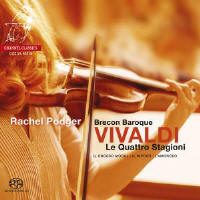Texte paru dans: / Appeared in: |
|
|
Outil de traduction ~ (Très approximatif) |
|
|
Reviewer: Robert
Maxham The concerto Il Riposo per il S. S. Natale receives just such a performance from Podger and the Brecon Baroque, and their gentleness and sensitivity seem perfectly suited to this sort of work—so well, in fact, that its undulating textures make some of the strongest impressions in the entire program. L’Amoroso, though perhaps suaver melodically, especially in its outer movements, explores a similar Affekt—and so do soloist and ensemble. The prepossessing Concerto Il Grosso Mogul serves as a highly virtuosic conclusion. Bumptious (unlike the earlier two concertos), this one offers the soloist cadenza-like passages, as well as an opportunity for fancy in the recitative-like slow movement, that must have amazed Vivaldi’s contemporaries and helped establish his reputation for almost crack-brained virtuosity. Yet Podger’s and the ensemble’s performance isn’t all cut and thrust, and offers contrasting moments of reflection set with delicate timbral tracery. Those who appreciate the ambiance of period instruments and Podger’s way with them should find these performances ... appealing in their own way ..., and the addition of three of Vivaldi’s most ingratiating concertos should make the collection irresistible to them. | |
|
|
|
|
|
|
|
Cliquez l'un ou l'autre
bouton pour découvrir bien d'autres critiques de CD |
|




